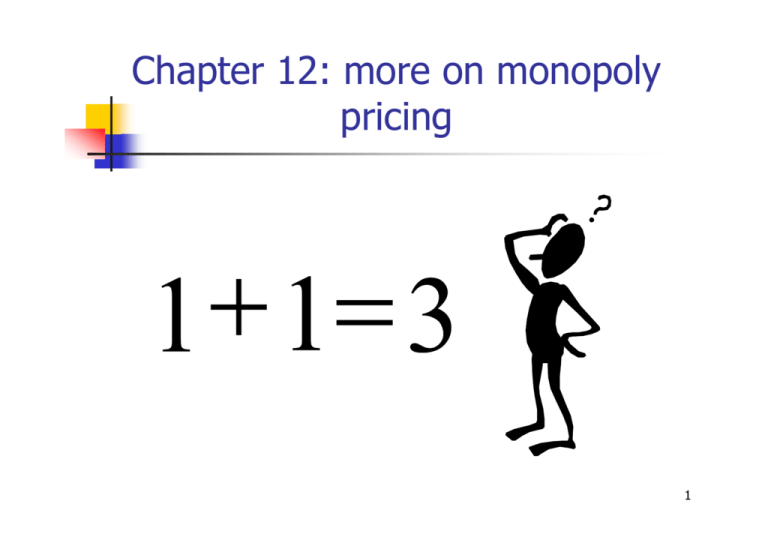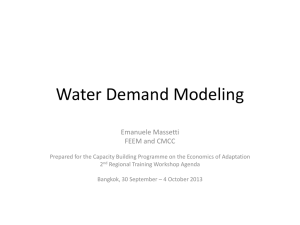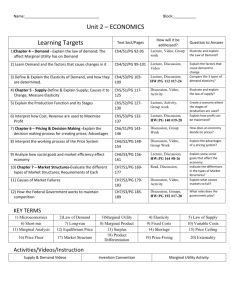Chapter 12: more on monopoly pricing
advertisement

Chapter 12: more on monopoly pricing 1 Motivation for price discrimination: 2 Types of price discrimination First-degree: the firm is aware of each individual buyer’s demand curve ==> relate to consumer’s surplus! Second-degree: the firm charges a different price, depending on the quantity each buyer purchases Third-degree: the firm breaks buyers into groups based upon their price elasticity of demand (what we discussed before) 3 First degree price discrimination 4 Price Discrimination: second degree • Demand for an individual customer (all customers are alike) • What condition must be fulfilled to make this price discrimination? 5 Can you set different prices for different groups of customers? Ability to identify and segregate the groups Demand elasticity is different No possibility for arbitrage (resell the good to 1 the other group) 1+ η2 p1 Optimal price is: = p2 Because MR1 = P1 (1 + 1 η1 1+ 1 η1 ) = P2 (1 + 1 η2 ) = MR 2 6 Examples of third-degree price discrimination Students, senior citizens for travel, ... (railway half-price identity card is also an example of two-part tarifs – see below) Airlines for business and tourists Seasonal price discrimination Prices for drugs, books, re-import not possible because of regulation 7 Third Degree Price Discrimination 8 Coupons as an example of price discrimination Esp. in U.S. firms distribute coupons (by mail or in newspapers) which give a rebate for the product Austria: Pizzamann, (Treuemarken),... Why is it better to give out coupons as compared to a general price cut?? Coupon users are more price-sensitive Only a small proportion of coupon receivers actually use them to claim the rebate Coupon reminds the customer each time that she gets lower price 9 Table 10.14 Repeat Buyers All purchasers Coupon users Purchasers not using coupons Chock Full o’ Nuts Maxwell House Folgers Hills Brothers 62 49 63 62 55 70 63 56 65 42 14 44 10 How to set an optimal coupon? Price elasticities of rich (R) and poor (P) clients: ηR = −2 and ηP = −5 P regular price, P-X price with coupon MC=2 P[1 + 1 ηR ] = (P − X )[1 + 1 ηP ] = MC P=4, X=1.5 Suppose, you get the coupon by mail, how come, that not everybody is redeeming it? 11 Problem 5 Ann McCutcheon is hired as a consultant to a firm producing ball bearings. The firm sells in two distinct markets, one of which is completely sealed off from the other. The demand curve for the firm’s output in the one market is P1=160 – 8Q1, where P1 is the price of the product, and Q1 is the amount sold in the first market. The demand curve for the firm’s product in the second market is P2=80 – 2Q2, where P2 and Q2 are price and quantity sold in the second market. The firm’s marginal cost curve is 5 + Q, where Q is the firm’s entire output. The firm asks Ann McCutcheon to suggest what its pricing policy should be. a) How many units of output should the firm sell in the second market? b) How many units of output should it sell in the first market? c) What price should it establish in each market? 12 Solution Problem 5 P1 = 160 − 8Q1 , P2 = 80 − 2Q 2 , MC = 5 + Q = 5 + (Q1 + Q 2 ) MR1 = 160 − 16Q1 , MR 2 = 80 − 4Q 2 Setting marginal revenue in each market equal to marginal cost: 1 6 0 − 1 6 Q 1 = 5 + (Q 1 + Q 2 ) an d 8 0 − 4 Q 2 = 5 + (Q 1 + Q 2 ) 155 − 17 Q 1 = Q 2 and 75 − Q 1 = 5Q 2 ⇒ Q 1 = 8 .3 3 a n d Q 2 = 1 3 .3 3 P1 = 1 6 0 − 8 (8 .3 3) = 9 3 .3 3 P 2 = 8 0 − 2 (1 3 .3 3 ) = 5 3 .3 3 13 Tying Occurs when a firm sells a product, the use of which requires the consumption of a complementary product The consumer is required to buy the complementary product from the firm selling the product itself Examples: Toner for computer printer, spare parts for cars, Price differently for consumer who use the good more/less intensively (in sum those using more often pay more) Brand name is protected Insurance that product works properly First item bought is more visible (price) Build network effects, consumers have switching costs 14 Tying in the printer market E.g. HP made half of its revenues with cartridges in 2002 Possiblity to refill old cartridges New chip in cartridges made it impossible to refill New EU law prohibiting this 15 Two-part tariffs Monopoly is inefficient, sum of consumer and producer surplus could be increased by producing more Optimal output should be where p=MC, but then consumers get the surplus So what should a “good” monopolist do ??? Set p=MC, then try to extract consumer surplus by other means, say, a one time fee (only correct, if all consumers are alike – otherwise you lose some) Examples: telephone, golf clubs, Disneyland 16 17 Example: Telephone pricing Telephone company is monopolist Demand: P = 100-0.5Q Marginal cost: MC = 10 (cents/minute) Optimal price for monopolist? Profit? Make also a graph Optimal price for a two-part tariff: charge a fee (Grundgebühr) and a price per minute Profit? 18 Solution: Telephone Pricing P = 100 – 0.5 Q MC should equal MR: TR = 100Q – 0.5 Q2 MR = 100 – Q MR = MC => 100 – Q = 10 => Q=90 P = 100 – 0.5 Q => P = 55 Π = 90* (55-10)= 4050 TWO PART TARIFF: Q = 180 Price/Minute = 10 Fee= 90*180/2 = 8100 Profit = 8100 Price 100 55 10 MC = 10 90 100 200 Quantity 19 20 XXXXXXXXXX Strong demand XXXXXXXXXX Weak demand 21 Two demand types: Set use fee at MC and entry fee equal to consumer surplus of strong type (A-F) If (A+B+C+D+E+F) > (2A+2C+D+E) Only the strong buys the good Set use fee at P*>MC and entry fee equal to consumer surplus of weak (A) If (A+B+C+D+E+F) < (2A+2C+D+E) All customers buy 22 Assume one strong and one weak demander (otherwise weighting necessary) 4 Options Charge high entry fee, such that only strong demander buys Charge low entry and MC price, such that both buy Charge low entry and price above MC Charge different entry fee for strong and weak demand Example clubs or credit cards 23 Pricing strategies for monopoly: Bundling Consumer valuation of the product not directly observed (see price discrimination) but the firm would like to know willingness to pay of each person Two (several) segments of the market exist Valuation of the product differs and Valuation by the two segments negatively correlated Marginal cost of producing is low Goods are on sale as a bundle Examples: restaurant menus, TV channels, quantity discount CD as compared to Single Sports tickets 24 Pure vs. mixed bundling Consumers have a reservation price r; i.e. their willingness to pay for the product Firm chooses prices p to set ________________ Pure bundling: only bundle is on sale Price can be calculated by looking at reservation price of costumers for the bundle Mixed bundling: both pure bundle as well as separate goods are on sale Prices difficult to obtain, either by experimentation (trial and error) or using a computer program (checking all possible price-combinations) 25 26 27 Example 28 29 30 31 32 33 Mixed or pure or no bundling? Above example: pure bundling best Pricing goals for bundling: Extraction: extract rent from consumers Exclusion: do not sell a good to a consumer who values it less than production cost (in case of bundle) Inclusion: Sell to all those, who have a reservation price higher than marginal cost In general not all goals can be reached 34 When is bundling useful ? If the segments of the market differ markedly in their evaluation of the products If the benefits of the products are negatively correlated among the segments of the market (but there are cases, where it is possible even in case of positive correlation). If marginal cost of producing is low (see example in book: high marginal costs for producing makes pure bundle less profitable as separate pricing, Tables 12.11, 12.10) Mixed bundling weakly dominates pure bundling) For pure bundling price strategy simple: take sum of reservation prices of customers For mixed bundling difficult 35 Some rules If goods‘ reservation prices positively correlated, maybe mixed bundling If goods perfectly negatively correlated, then pure bundling is best If marginal cost of producing is high (exceeding its reservation price), then no production best If reservation prices negatively correlated The higher marginal cost, the better is mixed bundling, If MC increase further, separate pricing best. 36 Peak-load pricing Demand for goods and services may shift over time During the day During the week Vacation, leisure activities, tourisme During season Electricity, gas, transport, telephone Holidays for school kids, weather Plant capacity does not change over time: Number of beds in hotel Energy production 37 Peaks and troughs Marginal revenue curves differ over time Marginal cost curves differ over time Working near capacity in high season Different form 3rd degree price discrimination 38 39 Price discrimination: Marginal cost = f(Q1 + Q2) Pricing solution: MR1(Q1) = MR2(Q2) = MC(Q1+Q2) Peak-load: Marginal costs: demanders use same capacity but at different times Pricing: MR1(Q1) = MC1(Q1) and MR2(Q2) = MC2(Q2) 40 Transfer Pricing Occurs in large firms when one division sells product to another division The transfer price is the price at which the transfer of product takes place within a firm If a market exists for the intermediate product, transfer price should be market price If no market exists --- transfer price should be marginal cost of intermediate product division 41 Transfer Pricing (given no external market) 42 Transfer Pricing (given a p. c. external market) 43 Problem 4 The Locust Corporation is composed of a marketing division and a production division. The marginal cost of producing a unit of the firm’s product is $10 per unit, and the marginal cost of marketing it is $4 per unit. The demand curve for the product is P = 100 – 0.01Q. There is no external market for the good made by the production division. a) What is the firm’s optimal output? b) What price should the firm charge? c) How much should the production division charge the marketing division for each unit of the product? 44 Solution Problem 4 Setting marginal revenue equal to marginal cost: MR = 100 – 0.02Q = 10+4 = MC => 86 = 0.02Q => Q = 4,300. P = 100 – 0.01(4,300) = $57 The transfer price should be set at the selling division’s marginal cost, $10, in the case of the producing division. 45 Problem 10 The Breen Company makes a scientific instrument used in chemical laboratories. The price of the instrument is set at 180 percent of average variable cost. The firm’s marketing manager receives a telephone call from a large chemical company offering to buy six of the instruments at $5,000 each. To meet the terms of the offer, Breen would have to manufacture the six instruments in the next three months, which would mean that Breen would lose orders for four instruments because of its limited production capacity. If fulfilled, these orders would be at the regular price of $7,200 per instrument. (Because the chemical firm was ordering six of the instruments, it wanted a reduced price of $5,000.) a) Should the firm accept the offer from the chemical company? Why or why not? b) If not, what is the minimum price it should ask the chemical company to pay? c) If you were a consultant to Breen’s chief executive officer, would you advise her to maintain or abandon the firm’s cost-plus pricing policy? Why? 46 Solution Problem 10 a) b) c) The firm should not accept the special order since the order will only contribute $6,000 toward fixed costs and profit, while the order displaces regular business which would contribute $12,800. In order to contribute the same to profit as the regular business, it would displace, the special order would need to be priced at $6,133.33 per instrument. We don’t have enough information to determine whether the current mark-up is profit maximizing. 47 Problem 6 The Morrison Company produces tennis rackets, the marginal cost of a racket being $20. Since there are many substitutes for the firm’s rackets, the price elasticity of demand equals about 2. In the relevant range of output, average variable cost is very close to marginal cost. a) The president of the Morrison Company feels that cost-plus pricing is appropriate for his firm. He marks up average variable cost by 100 percent to get price. Comment on this procedure. b) Because of heightened competition, the price elasticity of demand for the firm’s rackets increase to 3. The president continues to use the same cost-plus pricing formula as before. Comment on its adequacy. 48 Solution Problem 6 a) The profit-maximizing markup from marginal cost is 1/(1+1/ŋ)*100, which if the elasticity is (-)2 equals 100 percent. If marginal cost equals average variable cost, then the 100 percent markup from average variable cost is profit maximizing. b) If the elasticity changes to (-)3, then the profit-maximizing markup is 50 percent. 49






